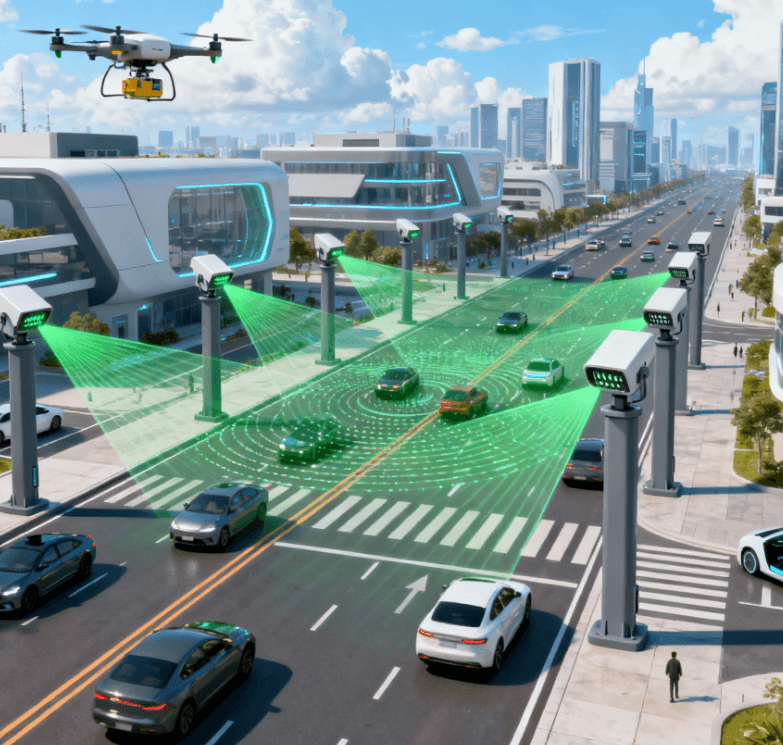As urban traffic evolves, roadside units (RSUs) are no longer simply communication hubs. They are increasingly expected to provide real-time situational awareness, event detection, adaptive signal control, and data input capabilities for vehicle-to-everything (V2X) systems. The challenge is obvious: how can RSUs provide high-precision, dependable data in complex, dynamic urban environments?
Millimeter-wave (MMW) radar is increasingly being identified as a core sensor. Unlike optical sensors, MMW radar produces stable outputs in all weather conditions, supports multi-target tracking, and can be deployed at scale with manageable maintenance requirements. Linpowave’s traffic solutions demonstrate these capabilities in practice, enabling multi-lane, multi-target tracking and producing structured vehicle data such as speed, distance, and trajectory (View Solutions).
All-Weather Perception: Stability in Real Roads
Heavy rain, fog, snow, low lighting at night, glare, dust, and vehicle occlusion are all common conditions on urban roads. Cameras and LiDAR frequently struggle in these conditions, either due to a lack of light, reflection, or a decreased signal range. In contrast, MMW radar employs high-frequency electromagnetic waves that penetrate these conditions, allowing for accurate detection of vehicle speed, distance, and angle.
Rain and fog make this abundantly clear during practical deployments. Cameras produce blurry or noisy images, whereas radar continues to provide precise measurements for all vehicles within the detection zone. This stability is critical for traffic signal controllers and edge computing modules to ensure that traffic management and incident detection continue uninterrupted.
Accurate Detection in Dynamic Traffic Environments
Urban intersections and road segments are highly dynamic, with frequent vehicle lane changes, pedestrians and non-motorized vehicles mixing with traffic, and large trucks or buses obstructing traffic on occasion.
MMW radar achieves centimeter-level distance accuracy and millisecond-level response, allowing it to track multiple targets even in congested environments. When combined with cameras, RSUs can more accurately determine whether a vehicle has violated traffic signals, detect pedestrian crossings, and measure congestion in real-time.
Linpowave's radar products have proven capable of tracking dozens to hundreds of targets at the same time, providing data for adaptive traffic signal control, congestion analysis, and risk assessment. This multi-target tracking capability is critical for intersections with complex geometry and high traffic volume.
Sensor Fusion: Radar as the Stable Backbone
Modern RSUs are rarely dependent on a single sensor type. Radar is an important component in multi-sensor fusion because it provides stable motion data that complements cameras and other perception devices.
For instance:
-
Radar data fills in the gaps left by cameras that are blinded by sunlight or obscured by vehicles.
-
Predictive traffic control algorithms can be based on velocity and trajectory data.
-
Radar provides redundancy, ensuring that critical traffic events are detected even if one sensor is temporarily unavailable.
The end result is a more durable, dependable RSU capable of supporting vehicle-to-infrastructure (V2I) communication and real-time edge analytics.
Scalable Deployment: Cost, Maintenance, and Domestic Production
Scaling RSU deployments to city-wide networks necessitates sensors that are small, low-power, and simple to maintain. Mechanical LiDAR and high-resolution cameras frequently have higher installation and maintenance costs.
The MMW radar offers:
-
A small form factor and low power consumption
-
Flexible installation with minimum alignment requirements.
-
Long operational life with minimal maintenance.
Linpowave radar solutions are intended to be used at multiple intersections with minimal engineering modifications. Domestic radar chip production further reduces procurement costs and ensures supply chain stability (More Info).
These benefits make MMW radar a viable option for large-scale urban infrastructure projects, enabling municipalities to maintain consistent and accurate traffic perception across hundreds of intersections.
Policy and Standards: Driving Radar Adoption
RSU upgrades have become a top priority as a result of vehicle-to-road-cloud integration strategies and smart city initiatives. RSUs now require sensors that can provide consistent, structured traffic data to support adaptive traffic management, safety monitoring, and connected vehicle networks.
MMW radar is naturally compatible with these requirements:
-
Tracking and measuring speeds across multiple lanes
-
Detecting the trajectory continuously
-
Integration with Traffic Management Systems
Radar sensors ensure RSUs meet regulatory expectations by providing consistent and actionable data, while also contributing to the long-term vision of intelligent urban traffic networks.
Practical Considerations in RSU Deployment
Installation Flexibility
When it comes to precise alignment, radar sensors are less sensitive than cameras. Engineers can optimize coverage for complex intersections by adjusting mounting angles and height without having to recalibrate extensively.
Integration with Existing Infrastructure
MMW radar provides structured velocity, distance, and trajectory data that is compatible with standard V2X interfaces. This allows for seamless integration into existing RSU platforms and edge computing modules.
Maintenance and Durability
Radar sensors are less affected by dust, rain, and snow than cameras, which require frequent cleaning and calibration. They are ideal for long-term urban deployments due to their durability and low maintenance requirements.
FAQ: Practical Questions Regarding RSU Deployments
Q1: Can radars be used instead of cameras?
Well, no. Radar is particularly good at detecting motion, whereas cameras provide semantic information. In multi-sensor RSU deployments, they complement each other.
Q2: How does rainfall or fog affect radar performance?
Radar experiences some signal attenuation but still produces stable outputs suitable for traffic monitoring.
Q3: Is multisensor fusion necessary?
Indeed. The combination of radar and cameras improves target tracking accuracy as well as event detection reliability.
Q4: Is it necessary to precisely align the radar during installation?
Radar installation is adaptable; for complete coverage, angle and position optimization are recommended.
Q5: Can radar accommodate large-scale RSU networks?
Sure. Radar's low power consumption, compact structure, and dependability make it ideal for citywide deployment.
Summarization
The perception of urban traffic is changing rapidly. RSU reliability is dependent on sensors that can operate in all weather conditions, track multiple dynamic targets, and provide structured, high-precision data.
Millimeter-wave radar, thanks to its stability, accuracy, and deployability, is emerging as the primary sensor for next-generation RSUs. When combined with cameras and other perception systems, it provides constant, actionable traffic data for V2X systems, adaptive signal control, and road safety. Linpowave’s radar products are specifically designed for these applications, supporting scalable urban deployment and enabling the next step in intelligent traffic systems (Linpowave Solutions).



